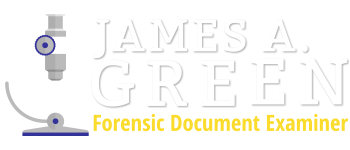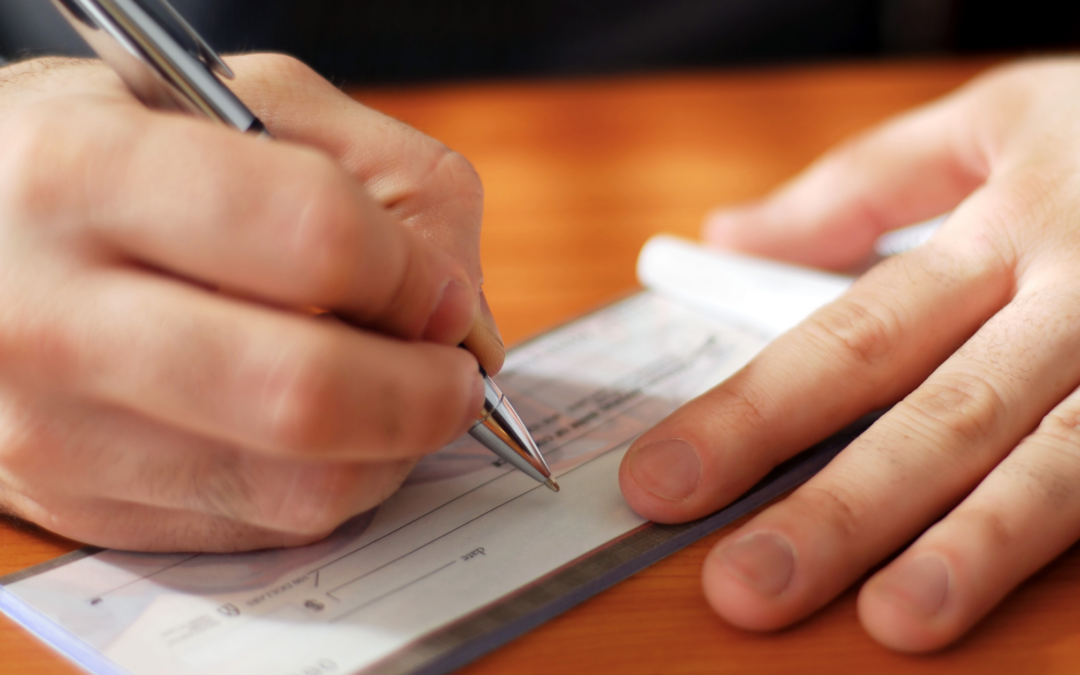In today’s advanced world, check fraud goes beyond simply forging a signature. One common type of check fraud is check washing, which involves chemically deleting a check’s details, then replacing the information. The original dollar amount of the check is usually increased during the fabrication process, giving it the nickname of a “raised check.” Check washing is currently an increasing problem and account holder’s should be aware of it. In this article, we’ll discuss the different methods of check washing and other check alteration processes. Recognition of check fraud techniques is important in learning how to avoid becoming a victim.
Forensic Document Examiner James Green is familiar with the techniques of check washing through his training and experience examining washed checks at the Eugene OR Police Department.
What is check washing and how is it conducted?
Check washing is a type of financial fraud in which an individual steals a pre-written check, chemically removes the original handwritten information using chemical(s,) then alters the details, such as the payee, dollar amount, and date, to their benefit. Although the process is not complex, the act of washing and altering a check requires a degree of skill and precision to ensure that the document retains an authentic appearance. Check washing can result in the fabricated checks being presented to businesses or private individuals causing significant financial losses.
Common methods used in check washing today
There are various chemicals used for check washing. Examples will not be identified in this article. The result should leave the existing pre-printed information legible while removing the ink from the pen used by the account holder. The goal is to essentially create a blank check to enable the forger to write the current date, their name (or one consistent with stolen identification they possess,) and a new (raised) dollar amount. The signature may be left intact if identification of the account holder was stolen with the check or the account holder’s signature may be simulated or traced. If they do not have a sample of the genuine signature, the forger may simply write a spurious signature in hopes it will not be compared with a signature card on file.
Check printing companies offer check protection against chemical eradications. If the check paper is subjected to liquid chemicals, the check will show a “VOID” indication or color change. The feature is worth your consideration.
How technology has enabled check washing to become more difficult to detect
Modern technology has resulted in modern responses by the criminal element. For example, many banks allow remote deposit capture (RMD,) for depositing checks without physically taking checks to their bank. A criminal may use the same process to deposit a forged check into their falsely established account. Although modern technology has removed a reliance on magnetic ink character recognition (MICR) information on a check, it is still in use. Magnetic ink may be easily purchased or “home made” for use in printing counterfeit checks.
Why it is important to stay informed on check fraud trends and techniques
Financial institutions and law enforcement agencies remain vigilant to the various methods of check manipulations. As business owners and consumers, we should also be aware of potential check fraud when payment by check is made by anyone we are not familiar with. If common sense security measures are not relied upon, banks and individuals can make themselves vulnerable to this kind of fraud. Take advantage of high-security checks with features such as custom watermarks, holograms, chemically reactive papers, and so forth.
Tips for preventing check fraud in businesses
Businesses can take simple steps in eliminating or greatly reducing their losses due to check frauds. A basic consideration is to keep checks secured in a safe or other secured location. Check forgers often target unlocked mailboxes to steal checks from outgoing mail. Rather than placing checks in the mail using an unsecured mailbox, consider using a more secure “blue box.” Even the blue box types are not immune from thefts. Taking mail, having checks or other important documents, directly to the post office is the most secure way to prevent mail theft incidents. Reducing the possibility of becoming a victim of check washing may also be enhanced by using speciality pens that are very difficult to chemically remove from paper. Also, using a check printing system makes the removal of the typed entries much more difficult because toner produced text is not readily removed from paper. Regularly reconciling bank accounts will catch irregularities, allowing a more punctual identification of a check forgery issue.
Get expert advice from Forensic Document Examiner James Green
Check-washing and other check fraud is rising, requiring individuals and businesses to remain diligent in their check writing and sending practices. If you have been the victim of a check fraud, contact your local police agency. If there is a need for a check to be examined to confirm an alteration or signature forgery, contact James Green. He has many years of experience as a Forensic Document Examiner helping individuals and businesses with forged checks and embezzlement matters.
In Conclusion
The U.S. Postal Inspection Service (USPIS) recovers over $1 billion in counterfeit checks and money orders each year. The rise of modern-day check washing and other check fabrications is a financial threat to individuals and businesses. Techniques and technology continue to develop making it possible for criminals to continue with this type of crime. Understanding how it works, the common methods used today, and how to prevent it is essential for everyone. By staying updated with the latest trends and technology, businesses can implement procedures to prevent check fraud. Remember to choose more secure checks and keep them in a secure manner. If a check crime is not pursued by your local police agency, a civil suit may be an alternative path to hold the forger accountable. To confirm a check altercation for evidence in your case, retain James Green.

